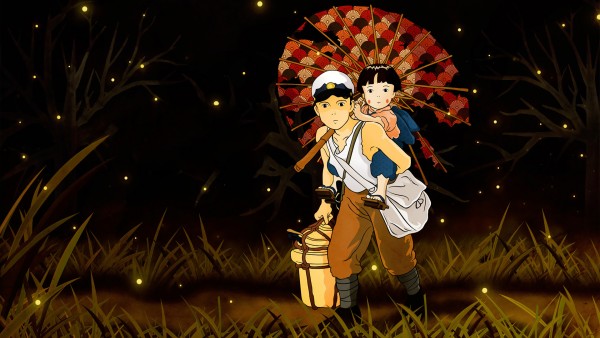
Welcome the April 2015 edition of the Akira Kurosawa Online Film Club. This month, we will be discussing the Studio Ghibli produced animated film Grave of the Fireflies, which was released in 1988. The film concludes our series of bombing themed films, following our viewing Shohei Imamura’s Black Rain in February and Kurosawa’s Rhapsody in August in March.
Grave of the Fireflies was written and directed by Isao Takahata, who co-founded the Japanese animation company Studio Ghibli with the studio’s figurehead Hayao Miyazaki, whose Princess Mononoke we watched last August. Takahata adapted the story from Akiyuki Nosaka’s semi-autobiographical novel, also titled Grave of the Fireflies and published in 1967. The book has since also been adapted twice as live action films, first in 2005 and again in 2008.
The powerful story follows two orghaned siblings, Seita and Setsuko, in their struggle to survive during the final months of the Second World War. The brother and sister pair need to depend on each other to find shelter and keep themselves fed and alive, while Japan is slowly succumbing to a military defeat.
Grave of the Fireflies is universally acclaimed, and it is typically considered not only one of the finest examples of animated films, but also one of the most powerful films of any kind that deal with the subject of war. The film is widely available in home video formats.
In May, the film club will be continuing with Kurosawa’s final film Madadayo. For the full film club schedule, see the film club page.
The floor is now open for your thoughts and comments on Grave of the Fireflies!






I watched the film today for perhaps the second time. The first time that I watched it was after it was released on DVD, at the beginning of the invasion of Iraq – operation shock and awe (I remember thinking that it was a brave film to release in the west given the climate at the time.) I hadn’t watched it since then because I found it far too upsetting. I found the film more upsetting this time because I now have a young son.
I won’t say any more about the film and will wait until others have a chance to see it before I offer my thoughts.
One thing: Grave of the Fireflies isn’t actually about the atomic bombings (I’m not sure if that’s what the actual connecting theme of the three films was, or just the bombing of Japan in general). I’m not sure that war is even the main theme of this film. For an animated film related to the atomic bombing of Hiroshima and Nagasaki maybe Barefoot Gen is a better choice?
Looking forward to hear what others thought of the film.